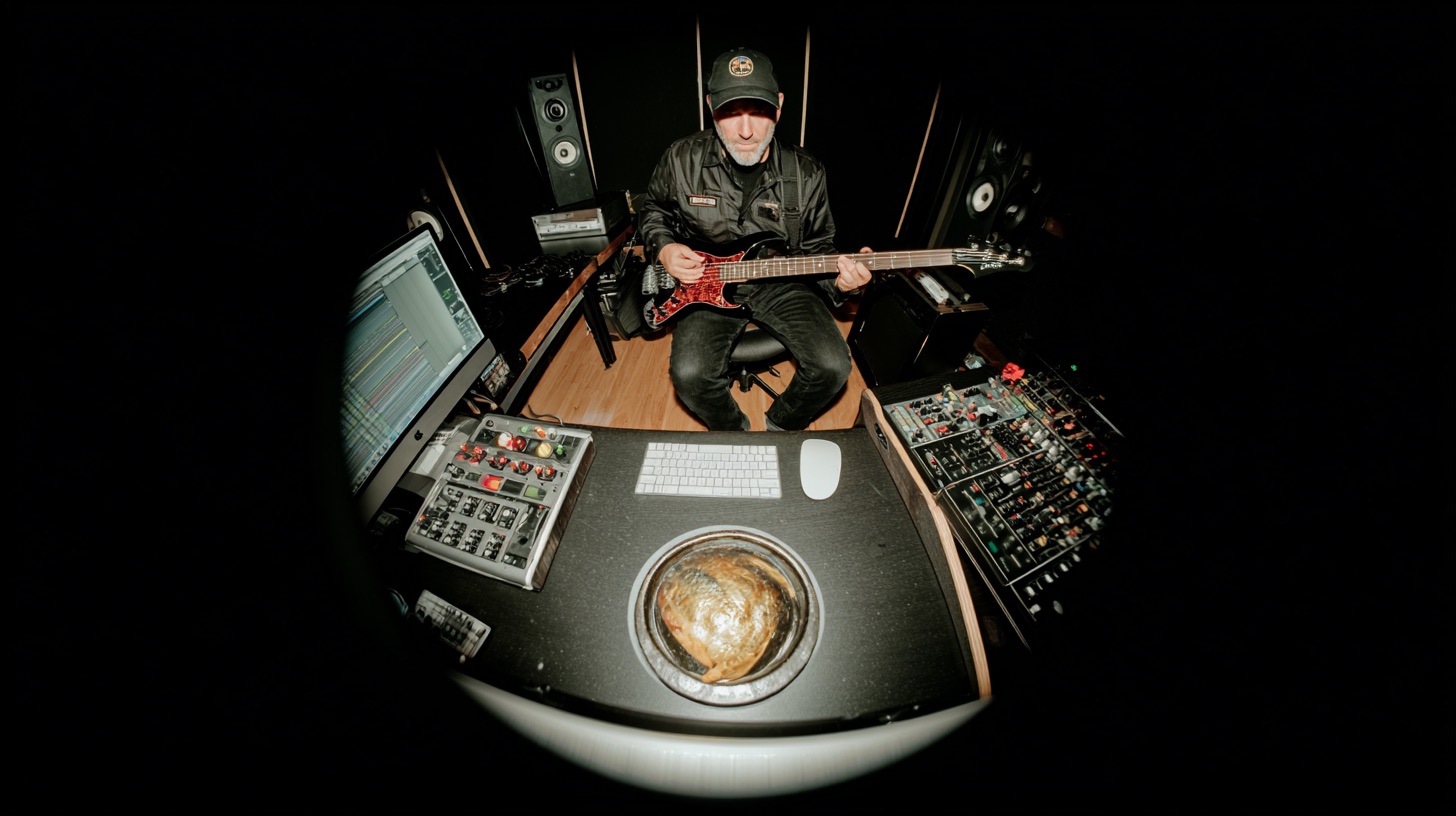
How to mix a modern metal kick drum
Nail The Mix Staff
Your kick drum. In modern metal, it’s not just part of the rhythm section; it’s a foundational weapon. It needs to be precise, powerful, and cut through a wall of low-tuned guitars and thunderous bass. It can even be used to inject intense energy and nail-biting tension into buildups. Getting that kick to sound polished and impactful, like the ones you hear on records by bands like Periphery, Gojira, or Spiritbox, can feel like a dark art. But it’s not magic – it’s about smart choices and targeted processing.
The bar for production quality in metal is sky-high these days. Even local bands are expected to have mixes that rival national acts. Gone are the days of thin, clicky, or undefined kick drums. Today's metal sound demands a kick that’s both felt and heard, with an almost inhuman level of consistency and punch. Let's dive into how you can achieve that in your own mixes.
Why Your Kick Drum is Crucial in Modern Metal
Modern metal is a different beast. We're talking incredibly low tunings (think 8-string guitars, drop F#, or even lower), dense arrangements, and the expectation of hyper-polished sound. This presents unique challenges for your kick drum:
- Fighting for Space: With guitars and bass occupying so much low-end territory, your kick needs to be carefully sculpted to find its own pocket without turning the mix into mud.
- The Need for Definition: Amidst fast double bass patterns and complex rhythms, each kick hit must be clearly defined. A flabby or indistinct kick will get lost instantly.
- Consistency is Key: Modern metal often features a lot of editing and sample replacement to achieve that ultra-tight, almost machine-like precision, especially in genres like djent or progressive metal. Over-editing without care can lead to robotic, lifeless percussion, which is often the problem with modern metal drums, but careful sample layering and humanization can fix this.
The good news? The tools and knowledge to craft these killer kick drums are more accessible than ever. With powerful DAWs, amazing drum sample libraries like GetGoodDrums or Superior Drummer, and a wealth of plugins, you can get pro results in your home studio.
Building the Foundation: Kick Drum Sample Selection & Layering
The quest for the perfect kick often starts with the samples. While a well-recorded acoustic kick is a great starting point, in modern metal, learning a few killer drum sample replacement techniques is key for consistency and punch.
Choosing Your Core Kick Sound
If you are working with an acoustic kick, make sure it's tuned well (often low, but with some attack) and appropriately muffled (think Evans EMAD or Aquarian SuperKick II heads, with internal pillows or blankets just touching the resonant head). Mic choices like an Audix D6, AKG D112, Shure Beta 52A inside, and maybe a Subkick or Yamaha NS10 woofer speaker mic outside can give you great raw material.
However, for many metal producers, samples are the go-to.
- Libraries: Companies like GetGoodDrums (check out their Invasion or PIV Matt Halpern Signature Pack), Toontrack Superior Drummer 3 (with its vast array of core sounds and SDX expansions like "Death & Darkness"), or Slate Drums offer meticulously recorded kick drums ready for metal.
- Consider the Shell: Maple kicks often offer a balanced tone, birch can be punchier with a good attack, and bubinga can provide deep lows. Experiment with what works for your track.
The Power of Layering: Click, Body, and Sub
One kick sample rarely does it all. Layering is where the magic happens. You're essentially building your ideal kick from multiple components, often using a sampler/drum replacement plugin like Slate Trigger 2, Drumagog 5, or your DAW's built-in sampler.
-
The "Click/Beater" Layer: This provides the attack and definition, helping the kick cut through.
- Sample Choice: Look for a sample with a sharp, clear transient. Sometimes this is a very processed, almost synthetic-sounding click. Samples from a plastic or hard felt beater work well.
- Processing: High-pass this layer quite aggressively (e.g., up to 100-300Hz) to remove unnecessary low-end mud. You might boost frequencies between 2kHz and 8kHz to emphasize the beater sound. A transient designer can be used to further sharpen the attack.
-
The "Body/Thump" Layer: This gives the kick its weight and fundamental tone.
- Sample Choice: This should be a fuller, more resonant sample. Think of the "oomph" of the kick.
- Processing: Focus on the low-mids and lows. You might boost around 60-100Hz for punch. Be careful with excessive low-mids (200-500Hz) as this can make the kick sound boxy.
-
The "Sub" Layer (Optional but Common): This adds deep, consistent low-end that you feel.
- Sample Choice: Often, this is a pure sine wave tuned to the key of the song or a specific fundamental (e.g., 40-60Hz). You can generate this with a synth or use dedicated plugins like Nicky Romero Kickstart 2 (though it's primarily a sidechain tool, its kick synthesis is handy) or even just a clean, deep 808-style sample.
- Processing: Low-pass this layer heavily (e.g., everything above 80-100Hz rolled off) so it doesn't interfere with the other layers. Ensure it's phase-aligned with your "Body" layer.
Pro Tip: Pay close attention to phase when layering! Zoom in on your waveforms and make sure the initial positive or negative swings align. Misaligned phase can lead to a weak, hollow sound. Most drum replacement plugins have phase flip and sample offset controls to help with this.
Sculpting with Precision: EQing Your Metal Kick Drum
EQ is where you shape your layered kick and make it sit perfectly in the mix. The goal is to EQ metal kick drums like a pro, delivering power that cuts through any dense mix. For more in-depth EQ strategies, check out our EQ hub page: Carve Your Core.
Essential EQ Moves for Kick Drum Clarity
- High-Pass Filter (HPF): Absolutely crucial. Remove unnecessary sub-rumble below 30-40Hz. This cleans up headroom and prevents your speakers from working too hard on inaudible frequencies. Use a fairly steep slope (18-24dB/octave).
- Cut Boxiness/Mud: Sweep around 200-500Hz with a fairly narrow Q on your EQ (like a FabFilter Pro-Q 3 or the channel EQ in your DAW). Find the frequencies that make the kick sound like a cardboard box or muddy, and gently pull them down. Don't overdo it, or you'll lose body.
- Scoop for Snare Interaction (Sometimes): A small dip around 200-300Hz on the kick can sometimes help the snare's body poke through, but be subtle.
Boosting the Good Stuff: Punch and Beater Attack
- Punch: The sweet spot for kick drum punch is usually between 60Hz and 100Hz. A moderate boost here (2-4dB) with a medium Q can add significant weight.
- Beater Attack/Click: This lives anywhere from 2kHz to 8kHz. Sweep to find where your beater sound is most prominent and give it a boost. This helps the kick cut through dense guitars. Plugins like the Waves SSL E-Channel or Plugin Alliance SSL 4000 E are classic for adding that aggressive top-end click.
The Kick and Bass Relationship: Carving Space in the Lows
This is one of the biggest challenges in modern metal due to low tunings. Kick and bass must work together, and properly balancing the kick drum and bass is essential for building a powerful, solid foundation.
- Identify Fundamental Frequencies: Use a spectrum analyzer to see where the kick's main energy sits (e.g., 60Hz) and where the bass guitar's fundamental is.
- Complementary EQ: If your kick is strong at 60Hz, consider a slight dip in the bass guitar around that same frequency, and maybe boost the bass slightly above or below it (e.g., 80-100Hz or 40-50Hz if it has sub content). The goal is for them to occupy slightly different spaces in the low end.
- Sidechain Compression (More on this later): A very common technique to make the bass duck out of the way of the kick.
Dynamic Control: Compressing Your Kick for Impact
Compression evens out the dynamics of your kick, adds sustain, and can significantly enhance its punch. For a deeper dive into compression, visit our Metal Compression Secrets hub page.
Individual Kick Track Compression: Shaping and Control
On your main kick track (or the blended output of your layers):
- FET-Style Compressors (e.g., 1176): Plugins like the Slate Digital FG-116, Arturia FET-76, or Waves CLA-76 are fantastic for adding aggression and punch.
- Attack: Start with a medium-fast attack (around 5-10ms, or 3-5 on an 1176 dial). You want to let the initial transient through before the compressor clamps down. Too fast, and you'll lose punch.
- Release: Set the release so the compressor "breathes" with the tempo of the song. A medium release often works well (e.g., 50-150ms). Too slow, and it won't recover before the next hit.
- Ratio: 4:1 or 8:1 are good starting points.
- Gain Reduction: Aim for 3-6dB of gain reduction on the loudest hits.
Parallel Compression: Adding Weight Without Squashing
Parallel compression is a secret weapon for a fat, powerful kick, helping you achieve clarity, punch, and space.
- Send your kick track to an auxiliary bus.
- On the bus, insert a very aggressive compressor. Think Empirical Labs Distressor (emulations like Slate Digital FG-Stress or UAD Distressor) or a DBX 160 style VCA compressor (Waves DBX 160).
- Crush it! Fast attack, fast release, high ratio. Aim for 10-20dB of gain reduction. It should sound over-the-top on its own.
- Blend this compressed signal back in underneath your main kick track, just enough to add thickness and sustain without sounding obviously compressed.
Next-Level Kick Drum Processing for Metal
Once your EQ and basic compression are set, these tools can take your kick to the next level.
Transient Shaping: Defining Your Kick's Envelope
Transient shapers allow you to directly control the attack and sustain portions of your kick.
- Plugins: SPL Transient Designer Plus, Native Instruments Transient Master, Schaack Audio Transient Shaper, or Plugin Alliance bx_transient designer.
- Increasing Attack: Adds more punch and click, making the kick more aggressive.
- Decreasing Sustain: Can tighten up a boomy kick, making it more focused and allowing faster double bass patterns to remain clear. Be careful not to shorten it too much, or it will sound thin.

100+ Insanely Detailed Mixing Tutorials
We leave absolutely nothing out, showing you every single step
Saturation & Distortion: Adding Bite and Harmonics
Subtle (or not-so-subtle) saturation can add warmth, character, and perceived loudness. It generates harmonics that help the kick cut through on smaller speakers or in dense mixes.
- Plugins: FabFilter Saturn 2, Soundtoys Decapitator, Softube Saturation Knob.
- Application: Try it on one of your kick layers (like the "body" or "click") or on the overall kick bus. Even a little bit can make a big difference. Tape saturation emulations can also add a nice cohesive glue.
Strategic Sidechaining for Maximum Punch
Sidechain compression is essential in modern metal, especially for creating clarity between kick, bass, and vocals.
- Kick to Bass: The most common application. Send your kick drum to the sidechain input of a compressor on your bass track. Set the compressor to subtly duck the bass guitar by a few dB every time the kick hits. This creates space for the kick's attack.
- Multiband Sidechaining: For even more precision, use a multiband compressor like FabFilter Pro-MB or Waves C6 on the bass. Only duck the low frequencies of the bass (e.g., below 150-200Hz) when the kick hits, leaving the bass's midrange and attack intact.
- Kick to Low-End Guitars: In extremely dense mixes with super low-tuned guitars, you might even consider subtly sidechaining the guitars' low-end from the kick, though this needs a very delicate touch.
Hear It In Action: Elevate Your Mixes with Nail The Mix
Crafting the perfect modern metal kick drum is a blend of technical know-how and artistic choices. We've covered a lot of ground here, from sample selection and layering to EQ, compression, and advanced processing. These techniques are powerful starting points you can apply to your productions right now.
But imagine seeing exactly how a world-class producer dials in these settings, makes those critical decisions, and fits that kick drum perfectly into a massive metal mix from scratch, using the actual multitracks from bands you love. That's what Nail The Mix is all about. Each month, you get to watch a top-tier producer mix a real song, explaining every plugin, every setting, and every creative choice. You get the raw multitracks to practice on yourself and access to a massive vault of past sessions and tutorials.
If you're serious about taking your metal productions to a professional level and want to see how these kick drum techniques (and a whole lot more) are applied in real-world scenarios, it's time to Unlock Your Sound: Mixing Modern Metal Beyond Presets with Nail The Mix. Stop guessing and start learning from the best in the business. Your kick drums (and entire mixes) will thank you for it.
Get a new set of multi-tracks every month from a world-class artist, a livestream with the producer who mixed it, 100+ tutorials, our exclusive plugins and more
Get Started for $1



